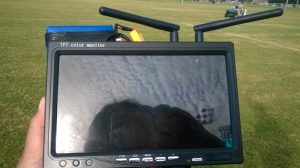Can a flyable aircraft be designed and built in 1 hour?
The Delta Wing Demonstrator is the result of this challenge in rapid aircraft design. Unfortunately, the answer was no. The aircraft actually required 1 hour and 20 minutes.
Specifications:
- 70 degree delta wing (foam board)
- Foam keel and motor mount
- Elevon flight control system (2 servos)
- Emax 2215-09 motor
- LiPo 2200 mAh 3S
After demonstrating that the DWD16 was flyable, it transitioned into a low-cost demonstrator aircraft. Multiple configurations variations were flight tested. Most of the variations were taped or glued to the delta wing structure and removed after testing.
- Stock: The stock delta wing flew; however, the wing rock at above 5-10 degrees AOA decreased flight handling qualities below what I considered acceptable. The wing rock magnitude created difficulty in hand launching.
- CG: After the initial flight, the CG was moved from 0% static margin to 15% static margin. During the design/build period, I carefully determined the ac and then designed the CG about that point. This was a good lesson in attention to details on unconventional designs, as I always tip test for CG on traditional wings.
- Canard: A canard was tested to evaluate a claim of wing roll reduction. A slight reduction in wing rock appeared at the expense of flight efficiency. Removed.
- Verticals: 5 different configurations of verticals were tested. The single aft vertical consistently gave the best stability and performance. The single upper vertical configuration reduced wing rock to acceptable levels within the effective flight envelope; the high AOAs where wing rock was visible with the single vertical have too much drag to maintain steady flight. Problem fixed. Interestingly, the twin verticals (i.e. SR71 style) shown in the videos demonstrated significantly elevated separation drag on the outboard vertical surfaces. CRS and I captured the separation with tufts during a test flight. A single forward vertical may reduce wing rock at moderate AOA, but is not as effective (and destabilizing in the yaw axis) as the aft mounting.
- Vectored Thrust: The original configuration included a cutout in the delta wing aft of the propeller. At low speeds, the control surface effectiveness decreased to essentially zero. LD, Simon, and I experienced a hard landing after losing roll and pitch control during a high alpha low-altitude test. My fix was to add elevons in the propwash, creating a type of vectored thrust. The maneuverability was significantly increased (e.g. loops in 3 chords). Increasing the area also slightly increased the static margin.

Wing rock in a delta wing configuration must absolutely be a consideration in the flight control system design. At the higher AOAs, the time to double (or cycles to double) is low enough to easily pull the pilot into PIO or uncontrollable attitudes.
The DWD16 also provided a platform for testing a new video transmission system.
As a demonstrator vehicle, adding tufts to the delta wing was instructive. The tufts visible show the leading edge vortex and the interaction with the twin verticals. At the higher angles of attack, watching the vortex structure is particularly interesting. Notice that the audio allows you to hear the tufts hitting the surface. I found this to be one of the most interesting flights with the aircraft. It is instructive to watch the wing rock time-to-double at 6:25. At lower AOAs, the limit cycle remains visible in the video.
The DWD16 is retired. The final flight gave me a hard lesson in aircraft design and failures. I experienced an inertial loading failure of the battery mount during a sustained roll. The battery disconnected from the receiver, disabling the FCS. I knew that the BEC (battery eliminator circuit) was the most likely failure but discounted the inertial loading. The worst part is that the propeller ingested parts of the propulsion wiring. Otherwise, this would have been a $5 failure.
The final and best configuration had a 15% static margin with a single central vertical stab. The delta wing had an amazing high alpha flight envelope. The turn rate (>360 deg/s) is tremendous at the expense of tremendous energy losses from the induced (vortex) drag and the separation drag. Overall flight efficiency for a delta wing is relatively poor, but the dynamic flight performance is excellent.
In fact, this DWD16 aircraft demonstrates the combat flight capability of delta wing fighters (Mirage, F-106, Mig 21, etc) at early/transient close range dynamic air combat. If a delta wing can get close enough, it may a strong likelihood of a single successful firing position. However, sustained combat advantages pass to higher energy efficient designs (e.g. F-16) as strongly promoted by Boyd.
As a demonstrator and given the low cost and minimal construction time, the DWD16 performed its mission successfully.

